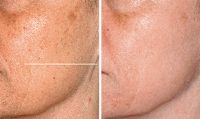- General Dermatology
- Eczema
- Chronic Hand Eczema
- Alopecia
- Aesthetics
- Vitiligo
- COVID-19
- Actinic Keratosis
- Precision Medicine and Biologics
- Rare Disease
- Wound Care
- Rosacea
- Psoriasis
- Psoriatic Arthritis
- Atopic Dermatitis
- Melasma
- NP and PA
- Skin Cancer
- Hidradenitis Suppurativa
- Drug Watch
- Pigmentary Disorders
- Acne
- Pediatric Dermatology
- Practice Management
- Prurigo Nodularis
Article
Sun spots: Cutting-edge treatment for solar lentigines uses combination approach
Author(s):
A combination approach is most effective for treating patients with solar lentigines, according to an expert.

Key Points

The Q-switched 532 nm Nd:YAG (KTP) has long been a mainstay of solar lentigines treatment, says Suzanne Kilmer, M.D., a dermatologist practicing in Sacramento, Calif., and associate clinical professor, University of California, Davis.
Combination approach
Use of the laser or intense pulse light (IPL) treatment kills the clone-making cells that trigger solar lentigines. Otherwise, the pigment repopulates with post-treatment sun-exposure.
Treatment with the Q-switched laser is usually limited to one or two sessions, versus several with the IPL, according to Dr. Kilmer. As a result, she prefers to use the laser.
Dr. Kilmer first uses a Q-switched laser to treat the more defined and darker lentigines. She follows that, during the same treatment session, with the fractional laser.
Fractional laser treatment (Solta Medical and Palomar), she says, disrupts the epidermis and dermis to trigger a wound and even skin tone.
These devices do not, however, offer permanent results, because fractional devices do not kill the cell clones that cause solar lentigines. The combination approach offers better short- and long-term results.
Bleaching creams
Dr. Kilmer uses hydroquinone, but not before treatment with the laser and fractionated device. Hydroquinone, she says, is especially effective at lightening trauma-induced pigmentation (versus biological pigmentation).
"Bleaching creams will lighten solar lentigines a little, but does not affect the clone of cells that is programmed to make the melanin in these lentigines.
"Patients who are only treated with hydroquinone will notice that the first time that they go back in the sun, they repigment," she says.
Dr. Kilmer uses topical bleaching creams especially after treatment of legs or darker skin types, which tend to get brown pigmentation after laser treatment. The hydroquinone bleaches the aftereffects of the laser, not the lentigines themselves.
Sunscreen
Researchers have found that in order prevent solar lentigines, it is important to protect from the longer ultraviolet wavelengths, Dr. Kilmer says.
"You need a good sunscreen with zinc oxide or chemically based avobenzone, which protects to 400 nm. Titanium dioxide, which is used commonly in makeup and sunscreen, only protects up to 360 nm.
"Wavelengths from 360 to 400 nm still can penetrate deep into the skin, and, therefore, can cause damage to the melanocytes and the deeper cells. This triggers not only lentigines, but also melanoma and skin cancer," Dr. Kilmer says.
Disclosure: Dr. Kilmer is on the medical advisory boards for Candela, ConBio and Lumenis. She conducts research for Cutera, Solta and Palomar.





